本文來自中時電子報
丁榮生/專題報導 (20060120)
近一兩個月,大陸及歐美建築媒體及報紙商業專欄,對中國大陸的火紅建築前景作了不下百篇的描述,標題多是:全球新建築奇蹟、08年北京將有世界最大的機場或奧運熱帶動北京蓋全球最高室外景觀台等讚揚之詞。
這些被指涉的建築,全是國際建築明星在大陸的光怪陸離(美國商業周刊評語)之作,因此罕見的批判也出現了,如:中國建築師仍是扶不起的阿斗、新中國風格建築在快速建設中的哪裡?兩相對照,國際建築界也意識到,在中國建築的光明前景下,相對地也拉出燭台下一圈深不見人的陰影。
●建房熱 歐美1世紀不敵北京10年變化
英文商業周刊最近以「中國的新建築奇觀」(China's New Architectural Wonders)為題,指奧運效應下,中國的國民生產總值是$1.93兆美金或16.8% GDP年成長率,因此人民擁有住房的型態已量變轉為質變,史無前例的建房熱,在北京10年的變化,簡直是歐美1世紀都還趕不上。
商周並舉大陸新建築奇蹟10大作品作為論據,除北京首都新機場、歌劇院等公共建築外,令人訝異地收錄一座商業私人開發案。這座才剛動土且「無法掛竹竿晾曬衣服」的玻璃住宅,預計可住進千戶人家,由美國普立茲克建築獎名師史蒂芬.侯最近發表。這座大街廓連棟玻璃高層集合住宅的設計理念著實驚人,他甚至說:「我在世界各地都不敢提出如此前衛的設計,沒想到北京接受了我!」原因出在他運用北京四合院天人合一概念,打造玻璃內庭,也就是高比例的公共設施,竟然中國人搶破頭,據說預售情形甚好。
也有媒體引述美國克利夫蘭一家廣告公司的數據,指稱中國居民住房建築上半年的廣告經費成長7.1%、商辦建築活動則增加7.4%;世界各地不同的住房類型,也史無前例地引進北京和上海,紐約時代周刊已捨棄北京、上海兩市,轉去作哈爾濱這些較少為人所知的新市鎮開發。洛杉磯一本建築雜誌說,這是最令人驚訝的事,竟然西方人對一個中國的2、3線城市都有興趣,顯見中國熱已到昏頭的地步。他們宣稱,能正確指出哈爾濱在哪裡的美國人,不會多於1%,也就是僅有1百多萬人看得懂哈爾濱這三個字的意義。
商周並認為,經過這2、3年的錘鍊,中國人已非吳下阿蒙,因為瑞士建築師賀榮&迪穆勒設計的奧運運動場,就像一座「鳥巢」,因為過於嚇人,還勞動總理溫家寶下令減掉屋頂的鋼筋量,他要求這必須是世界的最大的綠建築體育場。
●大膽建物紛紛矗立 西方建築師中國築夢
這種西方建築師在歐美日都無法實現的大膽建築美學。為何能在中國實現?商周認為,中國過往侷限於世人僅知的長城、紫禁城或蘇州庭園等「世界奇蹟」之後,深深覺得,在鄧小平經濟開放之後,應有新一波的「中國奇蹟」。
所以從法國建築師保羅.安得魯設計的北京大劇院,這座被暱稱為「水煮蛋」的透光劇院,今年將開幕拉起北京08年奧運新建築的序幕後,未來到10年上海萬國博覽會的這幾年,比美國五角大廈還大的北京首都機場擴建(英國爵士建築師諾曼.福斯特設計),將以1年處理5千5百萬旅客,一下子進入世界10大最繁忙機場等級為發展宏圖。
其他如澳洲PTW及Ove Arup公司以匪夷所思的聚四氟乙烯承載的液體結構所打造奧運游泳池「水立方體」、上海世界財經中心這座未來世界最高樓,以挑戰抗風壓結構在大樓尖頂開個洞,將開啟全球最高室外觀景台最為最大挑戰與賣點。而十大新建築奇蹟,其他還有中央電視台及長城腳下的公社、上海與洋山島(譯音)的東海大橋等。
全球新建築奇觀 聚焦大陸
-
Pedro Hsieh
Re: 全球新建築奇觀 聚焦大陸
BUSINESSWEEK原文的報導(並點選下面的10大建築連結):爆漿撒尿牛丸 寫:
英文商業周刊最近以「中國的新建築奇觀」(China's New Architectural Wonders)為題
http://www.businessweek.com/innovate/co ... 903049.htm
可能還是要拿中時的文章對照一下,畢竟翻譯還是要「信、達、雅」。
-
爆漿撒尿牛丸
直接貼上來好了。 
China's New Architectural Wonders
In our ongoing series on the world's most amazing buildings we look at the unprecedented building boom in Beijing and beyond
When global audiences tune in to watch the 2008 Olympics in Beijing, the world's fastest and strongest athletes won't be alone in striving for superlative achievements -- a new generation of innovative architecture is rising in China. Fueled by a surging economy (the latest Chinese census, released on Dec. 20, says the country's GDP is $1.93 trillion, or 16.8% higher than previously measured), China will soon be home to the world's largest airport, the world's first fully sustainable city, and the world's highest outdoor observation deck, to name just a few of its innovative architectural feats. Advertisement
With spending on China's residential building construction growing at 7.1% annually and nonresidential construction activity increasing by 7.4% (according to Cleveland-based researchers the Freedonia Group), the world's most populated country is experiencing a building boom of unprecedented scale.
The phenomenon is reaching beyond Beijing and Shanghai. As The New York Times recently reported, even the lesser-known northern city of Harbin is remaking itself with a new urban center. Built from scratch, a virtually instant skyline of residential and commercial skyscrapers is starting to sprout within a 285-square-mile area.
PUSHING THE BOUNDARIES. Still, it's Beijing and Shanghai, the nation's most populous cities, that are attracting the most attention. The roster of talent hired to complete projects in these two megacities reads like a Who's Who of star architects: Holland's Rem Koolhaas, Switzerland's Herzog & de Meuron, and Britain's Foster & Partners are all completing buildings scheduled to debut by the time the Olympic torch is lit.
But more remarkable than the architects' names are the projects themselves. The CCTV tower designed by Koolhaas, resembles nothing so much as a skyscraper tumbling into a somersault and required an entirely new structural system. The new Olympic stadium by Herzog & de Meuron -- nicknamed "the bird's nest" -- will be the world's largest "green" sports arena.
The following 10 projects range from residential to infrastructure. Each, in its way, pushes the boundaries of the architectural status quo. Together, they represent the wonders rising on the skyline of the new China.
The Commune, Beijing
First phase completed 2002, expansion scheduled for completion in 2010
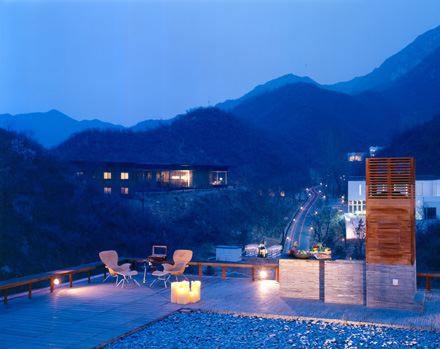
According to the U.S. Embassy to China, the country will be building 108 new airports between 2004 and 2009 -- including what will be the world's largest: the Beijing International Airport, designed by Foster & Partners. Set to open at the end of 2007, in time for the Beijing Olympics in 2008, the airport terminal will cover more than 1 million square meters, giving it a bigger footprint than the Pentagon.
It's designed to handle 43 million passengers a year initially and 55 million by 2015, figures that will probably push the new facility into the ranks of the top 10 busiest airports, going by the 2004 numbers from the Airports Council International. Given the scale and traffic, Foster & Partners focused on the traveler's experience, making sure that walking distances are short, for instance.
Building on Foster's experience designing Hong Kong's new mega-airport, the massive Chek Lap Kok, the sprawling Beijing terminal is housed under a single roof. To help passengers distinguish between different sections of the vast space, skylights cast different shades of yellow and red light across walls -- a subtle but innovative navigational aid. The architects also kept sustainability in mind: An environmental-control system reduces carbon emissions, and skylights situated on a south-east axis lessen solar heat, keeping the building cool.
Beijing International Airport, Beijing
Foster & Partners. Under construction, to be completed in late 2007
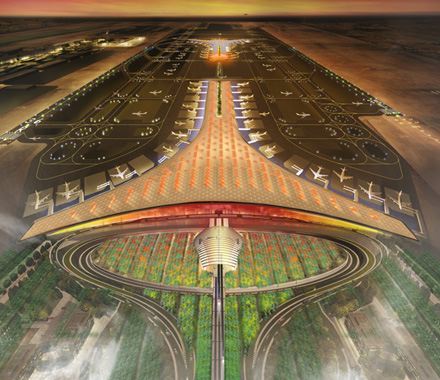
According to the U.S. Embassy to China, the country will be building 108 new airports between 2004 and 2009 -- including what will be the world's largest: the Beijing International Airport, designed by Foster & Partners. Set to open at the end of 2007, in time for the Beijing Olympics in 2008, the airport terminal will cover more than 1 million square meters, giving it a bigger footprint than the Pentagon.
It's designed to handle 43 million passengers a year initially and 55 million by 2015, figures that will probably push the new facility into the ranks of the top 10 busiest airports, going by the 2004 numbers from the Airports Council International. Given the scale and traffic, Foster & Partners focused on the traveler's experience, making sure that walking distances are short, for instance.
Building on Foster's experience designing Hong Kong's new mega-airport, the massive Chek Lap Kok, the sprawling Beijing terminal is housed under a single roof. To help passengers distinguish between different sections of the vast space, skylights cast different shades of yellow and red light across walls -- a subtle but innovative navigational aid. The architects also kept sustainability in mind: An environmental-control system reduces carbon emissions, and skylights situated on a south-east axis lessen solar heat, keeping the building cool.
Shanghai World Financial Center, Shanghai
Kohn Pedersen Fox Architects. Under construction, completion scheduled for 2008
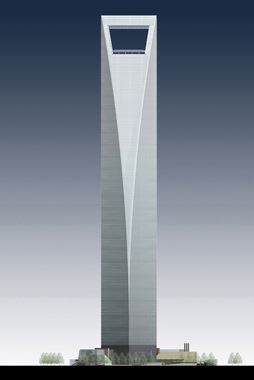
Rising in the Lujiazhui financial district in Pudong, the Shanghai World Financial Center is a tower among towers. The elegant 101-story skyscraper will be (for a moment, at least) the world's tallest when completed in early 2008.
One of the biggest challenges of building tall is creating a structure that can withstand high winds. The architects devised an innovation solution to alleviate wind pressure by adding a rectangular cut-out at the building's apex. Not only does the open area help reduce the building's sway but it also will be home to the world's highest outdoor observation deck -- a 100th-floor vista that will take vertigo to new heights.
National Swimming Center, Beijing
PTW and Ove Arup. Under construction, completion scheduled for 2008
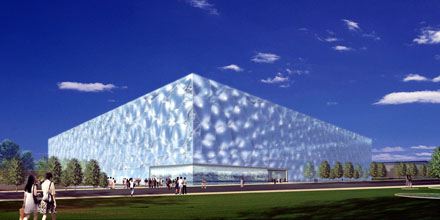
The striking exterior of the National Swimming Center, being constructed for the 2008 Olympic Games and nicknamed, the "Water Cube," is made from panels of a lightweight form of Teflon that transforms the building into an energy-efficient greenhouse-like environment. Solar energy will also be used to heat the swimming pools, which are designed to reuse double-filtered, backwashed pool water that's usually dumped as waste.
Excess rainwater will also be collected and stored in subterranean tanks and used to fill the pools. The complex engineering system of curvy steel frames that form the structure of the bubble-like skin are based on research into the structural properties of soap bubbles by two physicists at Dublin's Trinity College. The unique structure is designed to help the building withstand nearly any seismic disruptions.
Central Chinese Television CCTV, Beijing
OMA/Ole Scheeren and Rem Koolhaas. Under construction, scheduled for completion in 2008
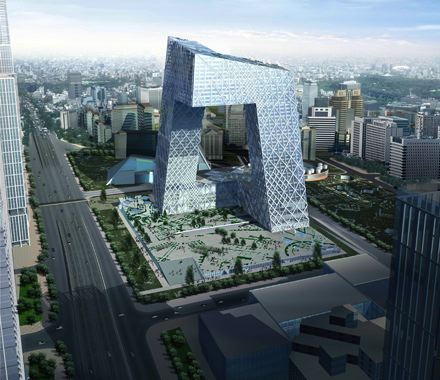
The design of the new Central Chinese Television (CCTV) headquarters defies the popular conception of a skyscraper -- and it broke Beijing's building codes and required approval by a special review panel. The standard systems for engineering gravity and lateral loads in buildings didn't apply to the CCTV building, which is formed by two leaning towers, each bent 90 degrees at the top and bottom to form a continuous loop.
The engineer's solution is to create a structural "tube" of diagonal supports. The irregular pattern of this "diagrid" system reflects the distribution of forces across the tube's surface. Designed by Rem Koolhaas and Ole Scheeren and engineered by Ove Arup, the new CCTV tower rethinks what a skyscraper can be.
Linked Hybrid, Beijing
Steven Holl Architects; Li Hu, lead architect. Groundbreaking on December 28, 2005, scheduled for completion in 2008
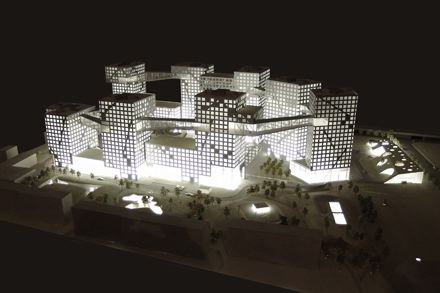
Linked Hybrid, which will house 2,500 people in 700 apartments covering 1.6 million square feet, is a model for large-scale sustainable residential architecture. The site will feature one of the world's largest geothermal cooling and heating systems, which will stabilize the temperature within the complex of eight buildings, all linked at the 20th floor by a "ring" of service establishments, like cafés and dry cleaners. A set of dual pipes pumps water from 100 meters below ground, circulating the liquid between the buildings' concrete floors.
The result: The water-circulation system serves as a giant radiator in the winter and cooling system in the summer. It has no boilers to supply heat, no electric air conditioners to supply cool. The apartments also feature gray-water recycling -- a process that's just starting to catch on in Beijing in much smaller buildings -- to filter waste water from kitchen sinks and wash basins back into toilets.
Dongtan Eco City, Dongtan
Masterplan by Arup, for the Shanghai Industrial Investment Corp. In planning stages, first phase to be completed in 2010
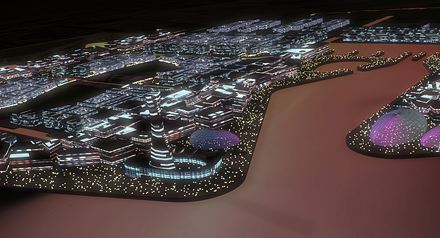
Developed by the Shanghai Industrial investment Corp., Dongtan Eco City, roughly the size of Manhattan, will be the world's first fully sustainable cosmopolis when completed in 2040. Like Manhattan, it's situated on an island -- the third-largest in China. Located on the Yangtze River, Dongtan is within close proximity of the bustle of Shanghai.
By the time the Shanghai Expo trade fair opens in 2010, the city's first phase should be completed, and 50,000 residents will call Dongtan home-sweet-sustainable-home. The goals to be accomplished in the next five years: systems for water purification, waste management, and renewable energy. An infrastructure of roads will connect the former agricultural land with Shanghai.
Olympic Stadium, Beijing
Herzog & de Meuron. Under construction, to be completed in 2008
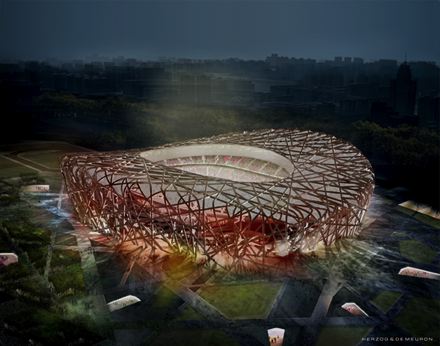
Sports stadiums have long followed the enduring design of one of the original wonders of the world, Rome's Coliseum. Herzog & de Meuron's National Stadium in Beijing is an attempt to rethink the classic sports-arena layout for more ecologically correct times.
The Swiss architects (of Tate Modern fame) wanted to provide natural ventilation for the 91,000-seat structure -- perhaps the largest "eco-friendly" sports stadium designed to date. To achieve this, they set out to create a building that could function without a strictly enclosed shell, yet also provide constant shelter for the audience and athletes alike.
To solve these design problems, they looked to nature for inspiration. The stadium's outer grid resembles a bird's nest constructed of delicately placed branches and twigs. Each discrete space within the facility, from restrooms to restaurants, is constructed as an independent unit within the outer lattice -- making it possible to encase the entire complex with an open grid that allows for natural air circulation. The architects also incorporated a layer of translucent membrane to fill any gaps in the lacy exterior.
Donghai Bridge, Shanghai/Yangshan Island
China Zhongtie Major Bridge Engineering Group, Shanghai # 2 Engineering Co., Shanghai Urban Construction Group. Officially opened in December, 2005
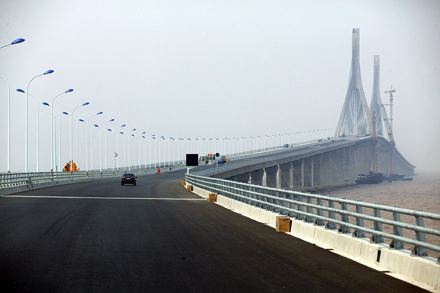
A key phase in the development of the world's largest deep-sea port was completed when China's first cross-sea bridge -- the 20-mile, six-lane Donghai Bridge -- was officially opened in December, 2005. Stretching across the East China Sea, the graceful cable-stay structure connects Shanghai to Yangshan Island, set to become China's first free-trade port (and the world's largest container port) upon its completion in 2010.
To provide a safer driving route in the typhoons and high waves known to hit the region, Donghai Bridge is designed in an S-shape. The structure, reported by Shanghai Daily to have cost $1.2 billion, will hold its title of China's -- and one of the world's -- longest over-sea bridge for only a couple of years, though. In 2008, the nearby 22-mile Hangzhou Bay Transoceanic Bridge, which also begins (or ends, depending on your journey) in Shanghai, will earn the superlative.
National Grand Theater, Beijing
Paul Andreu and ADP. Under construction, to be completed in 2008
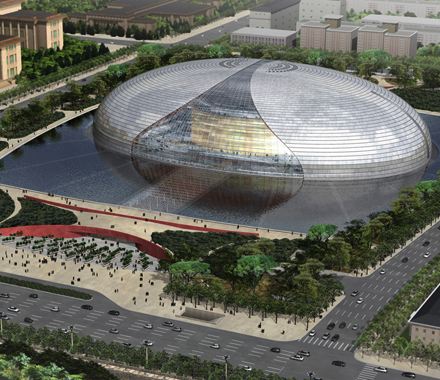
Located near Tiananmen Square, the 490,485-square-foot glass-and-titanium National Grand Theater, scheduled to open in 2008, seems to float above a man-made lake. Intended to stand out amid the Chinese capital's bustling streets and ancient buildings, the structure has garnered criticism among Bejing's citizens for clashing with classic landmarks like the Monument to the People's Heroes (dedicated to revolutionary martyrs), the vast home of the National People's Congress, or Tiananmen Gate itself (the Gate of Heavenly Peace).
French architect Paul Andreu is no stranger to controversy -- or to innovative forms. A generation ago, in 1974, his untraditional design for Terminal 1 of Paris's Charles de Gaulle airport was criticized for its unusual curves, yet Andreu's groundbreaking, futuristic building later was seen to distinguish de Gaulle from more generic European and international air hubs. (The same airport's Terminal 2E, also designed by Andreu, gained attention in 2004 when it collapsed, tragically killing four people.)
Beijing's daring National Grand Theater is as much a spectacle as the productions that will be staged inside in the 2,416-seat opera house, the 2,017-seat concert hall, and the 1,040-seat theater. At night, the semi-transparent skin will give passersby a glimpse at the performance inside one of three auditoriums, a feature that highlights the building's public nature.
China's New Architectural Wonders
In our ongoing series on the world's most amazing buildings we look at the unprecedented building boom in Beijing and beyond
When global audiences tune in to watch the 2008 Olympics in Beijing, the world's fastest and strongest athletes won't be alone in striving for superlative achievements -- a new generation of innovative architecture is rising in China. Fueled by a surging economy (the latest Chinese census, released on Dec. 20, says the country's GDP is $1.93 trillion, or 16.8% higher than previously measured), China will soon be home to the world's largest airport, the world's first fully sustainable city, and the world's highest outdoor observation deck, to name just a few of its innovative architectural feats. Advertisement
With spending on China's residential building construction growing at 7.1% annually and nonresidential construction activity increasing by 7.4% (according to Cleveland-based researchers the Freedonia Group), the world's most populated country is experiencing a building boom of unprecedented scale.
The phenomenon is reaching beyond Beijing and Shanghai. As The New York Times recently reported, even the lesser-known northern city of Harbin is remaking itself with a new urban center. Built from scratch, a virtually instant skyline of residential and commercial skyscrapers is starting to sprout within a 285-square-mile area.
PUSHING THE BOUNDARIES. Still, it's Beijing and Shanghai, the nation's most populous cities, that are attracting the most attention. The roster of talent hired to complete projects in these two megacities reads like a Who's Who of star architects: Holland's Rem Koolhaas, Switzerland's Herzog & de Meuron, and Britain's Foster & Partners are all completing buildings scheduled to debut by the time the Olympic torch is lit.
But more remarkable than the architects' names are the projects themselves. The CCTV tower designed by Koolhaas, resembles nothing so much as a skyscraper tumbling into a somersault and required an entirely new structural system. The new Olympic stadium by Herzog & de Meuron -- nicknamed "the bird's nest" -- will be the world's largest "green" sports arena.
The following 10 projects range from residential to infrastructure. Each, in its way, pushes the boundaries of the architectural status quo. Together, they represent the wonders rising on the skyline of the new China.
The Commune, Beijing
First phase completed 2002, expansion scheduled for completion in 2010

According to the U.S. Embassy to China, the country will be building 108 new airports between 2004 and 2009 -- including what will be the world's largest: the Beijing International Airport, designed by Foster & Partners. Set to open at the end of 2007, in time for the Beijing Olympics in 2008, the airport terminal will cover more than 1 million square meters, giving it a bigger footprint than the Pentagon.
It's designed to handle 43 million passengers a year initially and 55 million by 2015, figures that will probably push the new facility into the ranks of the top 10 busiest airports, going by the 2004 numbers from the Airports Council International. Given the scale and traffic, Foster & Partners focused on the traveler's experience, making sure that walking distances are short, for instance.
Building on Foster's experience designing Hong Kong's new mega-airport, the massive Chek Lap Kok, the sprawling Beijing terminal is housed under a single roof. To help passengers distinguish between different sections of the vast space, skylights cast different shades of yellow and red light across walls -- a subtle but innovative navigational aid. The architects also kept sustainability in mind: An environmental-control system reduces carbon emissions, and skylights situated on a south-east axis lessen solar heat, keeping the building cool.
Beijing International Airport, Beijing
Foster & Partners. Under construction, to be completed in late 2007

According to the U.S. Embassy to China, the country will be building 108 new airports between 2004 and 2009 -- including what will be the world's largest: the Beijing International Airport, designed by Foster & Partners. Set to open at the end of 2007, in time for the Beijing Olympics in 2008, the airport terminal will cover more than 1 million square meters, giving it a bigger footprint than the Pentagon.
It's designed to handle 43 million passengers a year initially and 55 million by 2015, figures that will probably push the new facility into the ranks of the top 10 busiest airports, going by the 2004 numbers from the Airports Council International. Given the scale and traffic, Foster & Partners focused on the traveler's experience, making sure that walking distances are short, for instance.
Building on Foster's experience designing Hong Kong's new mega-airport, the massive Chek Lap Kok, the sprawling Beijing terminal is housed under a single roof. To help passengers distinguish between different sections of the vast space, skylights cast different shades of yellow and red light across walls -- a subtle but innovative navigational aid. The architects also kept sustainability in mind: An environmental-control system reduces carbon emissions, and skylights situated on a south-east axis lessen solar heat, keeping the building cool.
Shanghai World Financial Center, Shanghai
Kohn Pedersen Fox Architects. Under construction, completion scheduled for 2008

Rising in the Lujiazhui financial district in Pudong, the Shanghai World Financial Center is a tower among towers. The elegant 101-story skyscraper will be (for a moment, at least) the world's tallest when completed in early 2008.
One of the biggest challenges of building tall is creating a structure that can withstand high winds. The architects devised an innovation solution to alleviate wind pressure by adding a rectangular cut-out at the building's apex. Not only does the open area help reduce the building's sway but it also will be home to the world's highest outdoor observation deck -- a 100th-floor vista that will take vertigo to new heights.
National Swimming Center, Beijing
PTW and Ove Arup. Under construction, completion scheduled for 2008

The striking exterior of the National Swimming Center, being constructed for the 2008 Olympic Games and nicknamed, the "Water Cube," is made from panels of a lightweight form of Teflon that transforms the building into an energy-efficient greenhouse-like environment. Solar energy will also be used to heat the swimming pools, which are designed to reuse double-filtered, backwashed pool water that's usually dumped as waste.
Excess rainwater will also be collected and stored in subterranean tanks and used to fill the pools. The complex engineering system of curvy steel frames that form the structure of the bubble-like skin are based on research into the structural properties of soap bubbles by two physicists at Dublin's Trinity College. The unique structure is designed to help the building withstand nearly any seismic disruptions.
Central Chinese Television CCTV, Beijing
OMA/Ole Scheeren and Rem Koolhaas. Under construction, scheduled for completion in 2008

The design of the new Central Chinese Television (CCTV) headquarters defies the popular conception of a skyscraper -- and it broke Beijing's building codes and required approval by a special review panel. The standard systems for engineering gravity and lateral loads in buildings didn't apply to the CCTV building, which is formed by two leaning towers, each bent 90 degrees at the top and bottom to form a continuous loop.
The engineer's solution is to create a structural "tube" of diagonal supports. The irregular pattern of this "diagrid" system reflects the distribution of forces across the tube's surface. Designed by Rem Koolhaas and Ole Scheeren and engineered by Ove Arup, the new CCTV tower rethinks what a skyscraper can be.
Linked Hybrid, Beijing
Steven Holl Architects; Li Hu, lead architect. Groundbreaking on December 28, 2005, scheduled for completion in 2008

Linked Hybrid, which will house 2,500 people in 700 apartments covering 1.6 million square feet, is a model for large-scale sustainable residential architecture. The site will feature one of the world's largest geothermal cooling and heating systems, which will stabilize the temperature within the complex of eight buildings, all linked at the 20th floor by a "ring" of service establishments, like cafés and dry cleaners. A set of dual pipes pumps water from 100 meters below ground, circulating the liquid between the buildings' concrete floors.
The result: The water-circulation system serves as a giant radiator in the winter and cooling system in the summer. It has no boilers to supply heat, no electric air conditioners to supply cool. The apartments also feature gray-water recycling -- a process that's just starting to catch on in Beijing in much smaller buildings -- to filter waste water from kitchen sinks and wash basins back into toilets.
Dongtan Eco City, Dongtan
Masterplan by Arup, for the Shanghai Industrial Investment Corp. In planning stages, first phase to be completed in 2010

Developed by the Shanghai Industrial investment Corp., Dongtan Eco City, roughly the size of Manhattan, will be the world's first fully sustainable cosmopolis when completed in 2040. Like Manhattan, it's situated on an island -- the third-largest in China. Located on the Yangtze River, Dongtan is within close proximity of the bustle of Shanghai.
By the time the Shanghai Expo trade fair opens in 2010, the city's first phase should be completed, and 50,000 residents will call Dongtan home-sweet-sustainable-home. The goals to be accomplished in the next five years: systems for water purification, waste management, and renewable energy. An infrastructure of roads will connect the former agricultural land with Shanghai.
Olympic Stadium, Beijing
Herzog & de Meuron. Under construction, to be completed in 2008

Sports stadiums have long followed the enduring design of one of the original wonders of the world, Rome's Coliseum. Herzog & de Meuron's National Stadium in Beijing is an attempt to rethink the classic sports-arena layout for more ecologically correct times.
The Swiss architects (of Tate Modern fame) wanted to provide natural ventilation for the 91,000-seat structure -- perhaps the largest "eco-friendly" sports stadium designed to date. To achieve this, they set out to create a building that could function without a strictly enclosed shell, yet also provide constant shelter for the audience and athletes alike.
To solve these design problems, they looked to nature for inspiration. The stadium's outer grid resembles a bird's nest constructed of delicately placed branches and twigs. Each discrete space within the facility, from restrooms to restaurants, is constructed as an independent unit within the outer lattice -- making it possible to encase the entire complex with an open grid that allows for natural air circulation. The architects also incorporated a layer of translucent membrane to fill any gaps in the lacy exterior.
Donghai Bridge, Shanghai/Yangshan Island
China Zhongtie Major Bridge Engineering Group, Shanghai # 2 Engineering Co., Shanghai Urban Construction Group. Officially opened in December, 2005

A key phase in the development of the world's largest deep-sea port was completed when China's first cross-sea bridge -- the 20-mile, six-lane Donghai Bridge -- was officially opened in December, 2005. Stretching across the East China Sea, the graceful cable-stay structure connects Shanghai to Yangshan Island, set to become China's first free-trade port (and the world's largest container port) upon its completion in 2010.
To provide a safer driving route in the typhoons and high waves known to hit the region, Donghai Bridge is designed in an S-shape. The structure, reported by Shanghai Daily to have cost $1.2 billion, will hold its title of China's -- and one of the world's -- longest over-sea bridge for only a couple of years, though. In 2008, the nearby 22-mile Hangzhou Bay Transoceanic Bridge, which also begins (or ends, depending on your journey) in Shanghai, will earn the superlative.
National Grand Theater, Beijing
Paul Andreu and ADP. Under construction, to be completed in 2008

Located near Tiananmen Square, the 490,485-square-foot glass-and-titanium National Grand Theater, scheduled to open in 2008, seems to float above a man-made lake. Intended to stand out amid the Chinese capital's bustling streets and ancient buildings, the structure has garnered criticism among Bejing's citizens for clashing with classic landmarks like the Monument to the People's Heroes (dedicated to revolutionary martyrs), the vast home of the National People's Congress, or Tiananmen Gate itself (the Gate of Heavenly Peace).
French architect Paul Andreu is no stranger to controversy -- or to innovative forms. A generation ago, in 1974, his untraditional design for Terminal 1 of Paris's Charles de Gaulle airport was criticized for its unusual curves, yet Andreu's groundbreaking, futuristic building later was seen to distinguish de Gaulle from more generic European and international air hubs. (The same airport's Terminal 2E, also designed by Andreu, gained attention in 2004 when it collapsed, tragically killing four people.)
Beijing's daring National Grand Theater is as much a spectacle as the productions that will be staged inside in the 2,416-seat opera house, the 2,017-seat concert hall, and the 1,040-seat theater. At night, the semi-transparent skin will give passersby a glimpse at the performance inside one of three auditoriums, a feature that highlights the building's public nature.
-
eichi_hsu
